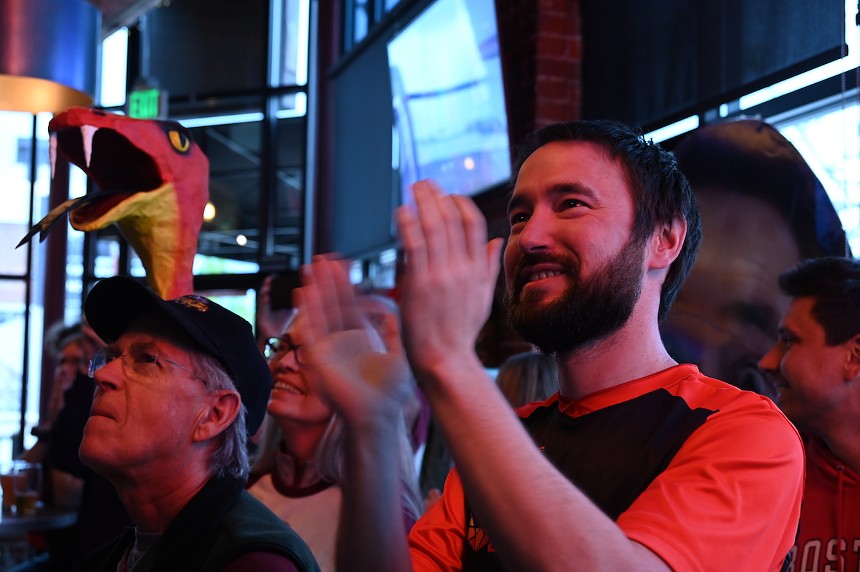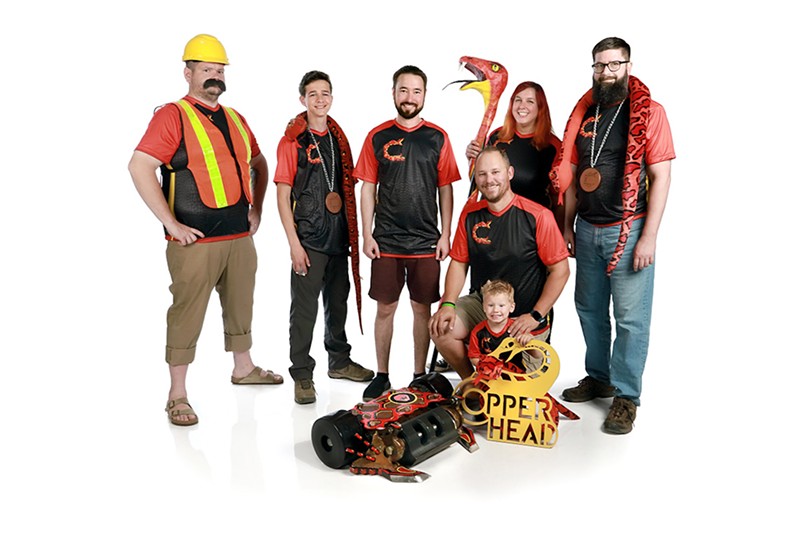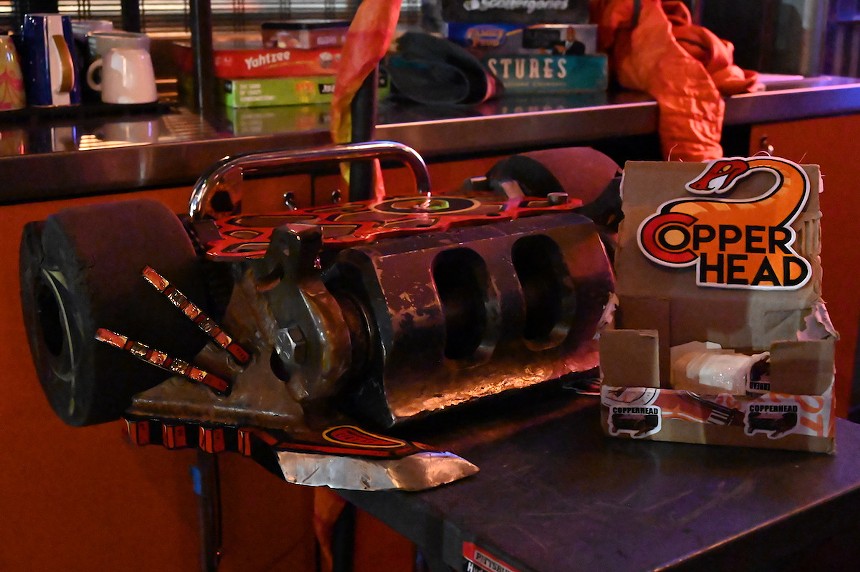Even with the Rockies' disappointing season, Colorado has been rich with playoff contenders of late. The fiercest of all could be Copperhead, the robot programmed to mangle and kill other robots with its rotating metal drum that makes it look like a Roomba from Mad Max.
Copperhead has been on the Discovery Channel's BattleBots for four seasons, and this year it's competing "exceptionally well," according to team captain Luke Quintal.
"We've always had a pretty mediocre season, for the most part. We always thought we had a pretty good robot, but for one reason or another, things would break or go wrong," says Quintal, who became a fan of the sport when he was twelve and is the team's third captain, but only the first to take Copperhead into a BattleBots championship. "So we never had a ton of publicity on the show, but this past season we actually had the best season we ever had."
On May 18, the Fat Sully's South Broadway location hosted a watch party for Quintal, his parents, some friends and a few Copperhead fans and teammates, as the robot battled through round sixteen in the penultimate match of the season. More people showed up at the pizza joint to watch this show than they did to watch the Nuggets go two games up on the Lakers.
On May 18, the Fat Sully's South Broadway location hosted a watch party for Quintal, his parents, some friends and a few Copperhead fans and teammates, as the robot battled through round sixteen in the penultimate match of the season. More people showed up at the pizza joint to watch this show than they did to watch the Nuggets go two games up on the Lakers.
BattleBots, which used to be on Comedy Central from 2000 to 2002, is airing its season finale on Thursday, May 25, and Copperhead is poised to win the Giant Nut, which is equivalent to the Lombardi Trophy or the Stanley Cup for combat robots. Teams from all over the U.S. as well as England, Brazil, Australia, New Zealand, the Netherlands and Canada have been competing this year; the Copperhead team is the only one from Colorado and has members from along the Front Range.
Although the sport seems suited to engineers, the robot builders "come from all walks of life," says Quintal, who works as a computer server administrator by day. Copperhead's drum spinner is operated by Chad New, president of Nature's Box Pet Emporium, Colorado's largest pet shop and an original sponsor of the robot. Other Copperhead supporters include Hall of Justice Comics and Collectibles in Parker and Gear Team Apparel out of San Antonio.
Some of the team members are holdovers from the days when the robot was Poison Arrow, which competed on BattleBots in 2016. That robot, which ran on four wheels instead of two, was designed by Zachary Goff, who'd created another robot named UnMakerBot that competed in smaller events the year before.
"Unmakerbot was essentially a test bed for what would eventually become Poison Arrow," Quintal says. "Zach designed Copperhead as a replacement to Poison Arrow. Copperhead was designed to be more competitive."
Goff served as team captain during Poison Arrow's lone season on the show and for two of Copperhead's seasons before being succeeded in 2021 by Robert Cowan, a well-known combat robot builder with a large following on his DIY social media pages. Cowan felt "kind of burnt out" after that season, says Quintal, who'd joined the team when Copperhead was created and became captain last year.
"Unmakerbot was essentially a test bed for what would eventually become Poison Arrow," Quintal says. "Zach designed Copperhead as a replacement to Poison Arrow. Copperhead was designed to be more competitive."
Goff served as team captain during Poison Arrow's lone season on the show and for two of Copperhead's seasons before being succeeded in 2021 by Robert Cowan, a well-known combat robot builder with a large following on his DIY social media pages. Cowan felt "kind of burnt out" after that season, says Quintal, who'd joined the team when Copperhead was created and became captain last year.
Other teammates include Heather Williams, Quintal's girlfriend, who has a background in political science, and nineteen-year-old Alec Mallinger, a student at the Colorado School of Mines studying mechanical engineering who has a YouTube page on building robots. Mallinger is also a fan of Cowan, who boasts nearly 50,000 subscribers on his YouTube page.
In BattleBots matches, two robots go into an arena that's about 28 feet by 28 feet, with metal grinders called hazards on the sides, buzz saws that pop out of the ground, screws that come out of the wall and drag robots to the hazards, and platforms known as shelves that raise robots above each other.
A robot has three minutes to knock out its opponent. One is often destroyed before the end of the match; if neither dies, the judges decide the winner based on damage, control and aggression. "You never want to go to the judges," Quintal says. "Usually, you try to go for the knockout. Sometimes it can be kind of controversial when it goes to the judges."
The actual competitions occur in Las Vegas during two weeks in October, but non-disclosure agreements require that participants and fans keep quiet until the shows air. "Some people leak stuff online, but we have a very passionate bunch of moderators on all the social media sites like Reddit and Facebook," Quintal says. "There are a lot of people who know what happened, but everyone's pretty tight-lipped about it."
The Discovery Channel airs one episode a week for twenty weeks; each season starts with fifty robots, and the tournament includes the best 32.
The Discovery Channel airs one episode a week for twenty weeks; each season starts with fifty robots, and the tournament includes the best 32.

Team captain Luke Quintal applauds as he watches BattleBots with friends, family and fans.
Bennito L. Kelty
"We just run it into our opponent, and it just sends them flying through the air and breaking parts along the way," he says.
Even though it weighs 240 pounds and is made of inch-thick steel in most areas, at less than a foot tall and about three feet wide, Copperhead is the second-smallest robot in BattleBots, which makes it more durable and harder to knock out. "The smaller you make something, it allows you to have more weight allocated for really thick armor," Quintal says. "We try to make our robot as small as possible."
It also has what the team calls "forks" — attachments in the front that stick out past the drum and get underneath the opponent. Many robots have this design, which help with the "ground game" — getting an advantage by flipping opponents in the air.
Copperhead may be deadly from the front, but Quintal and his crew have to pay attention to its Achilles heel: the backside, where the steel is only an eighth of an inch thick. "When I'm driving, no matter what, my highest priority is always to keep the front of the robot facing its opponent," Quintal says. "The driving, knowing how to work on the robot and just the years of evolving the robot has contributed to our success."
Copperhead moves around on two tires, which presents another weakness: By taking out one of its tires, an opposing robot can deliver a knockout blow to its backside. But the team members have gotten creative, figuring out that they can use Copperhead's drum spinner to move it around. When they won last week against heavy favorite End Game from New Zealand, they did so by driving Copperhead upside down after he was flipped through the air.
The taller robots give Copperhead some trouble, because it's harder to hit them with the drum spinner. "Our robot is designed to fight most other types of robots, and sometimes people bring out these really wacky designs to counter our strategy," he adds. "There's not really a lot we can do about that."
Last season, Copperhead lost early in the tournament to the championship runner-up, Witch Doctor, after getting hit from behind and losing one of the chains that helps it run. Before the tournament this season, the pizza-themed robot Ripperoni beat Copperhead the same way.
Copperhead has had "very fast" knockouts this season, Quintal says, with matches usually only lasting between ten and thirty seconds. He estimates that Copperhead has only spent a total of two minutes actually fighting this year, not including the ten-second count by a referee that gives robots a last chance to get back into the fight.
"Our first three matches were over in ten seconds," he says. "Ideally, we all want to have good matches that go a little bit longer. The production crew doesn't like them to get over that fast."
Quintal attributes Copperhead's success this year to "minor incremental upgrades" as well as the team's experience. "A lot of times when the robots fail, something really minor happens, like a wire pops out, a tiny little wire comes loose or you don't program your speed controllers correctly," he says. "It's the small details that make a successful robot successful." "Our first three matches were over in ten seconds," he says. "Ideally, we all want to have good matches that go a little bit longer. The production crew doesn't like them to get over that fast."
Copperhead's performance has taken even Quintal by surprise; his team was thinking of retiring the robot after the last few disappointing seasons. "We never lived up to our performance expectations," Quintal says. "But now that we've done so well in this currently airing season, it's brought new life into the team."
The fan base has grown, and the team has been selling more merchandise, which helps subsidize the project. The robots are expensive to build. Even though Quintal describes them as "glorified RC cars," he estimates the team has spent $35,000 over the past few years, and that other teams have likely spent more.
But it's paid off. Although Quintal doesn't offer any spoilers, he thinks that by the end of the season, "the fan base will explode."
Copperhead took a substantial beating this season and will need a complete rebuild before the next, Quintal says, then adds: "We did a lot of damage as well."














